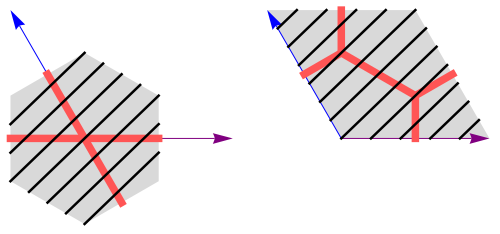I am working with a triangular lattice $L=\{n_1 a_2 + n_2 a_2 : n\in\mathbb{Z}^2 \}$ and $a_1 = \pmatrix{1 \\ 0}$ and $a_2 = \frac{1}{2} \pmatrix{-1 \\ \sqrt{3}}$, and I want to compute the Pontryagin dual of a strip of this lattice, i.e.
$$L_N := \{n_1 a_2 + n_2 a_2 : n_1 \in \mathbb{Z}, n_2 = 0,...,N \} \subset L.$$
It is known that the Pontryagin dual of the triangular lattice is the set of all characters $\chi_k : L \to S^1$ such that $$ \chi_k(x) = e^{ik\cdot x}, \quad x\in L $$ with $k\in B$, where $B$ is the first Brillouin zone of the triangular lattice (or any retiling of it).
It is also know that for a LCA group $G$ and a closed subgroup $H$ of $G$. The Pontryagin dual of $H$ is the quotient $\hat{H} = \hat{G}/H^{\perp}$, where $H^{\perp} = \{\chi \in \hat{G} : \chi(x) = 1\ \forall x\in G\}$.
I was hoping that I could use this train of thought to determine the Pontryagin dual of $L_N$.
It is true that $L_N \subset L$ but $(L_N,+)$ is not a closed subgroup of $(L,+)$ (as thankfully pointed out by @MateuszKwaśnicki) so one cannot apply the above statement to determining the Pontryagin dual of $L_N$.
Question: If $H$ is a quotient group of $G$, i.e. $H = G/Q$ for some $Q$, is there a clear relationship between $\hat{G}$ and $\hat{H}$, as is the case when $H$ is a closed subgroup of $G$?
Any hints on computing the dual of the lattice strip would be much appreciated, as would any references that deal with this sort of theory.
Edit notes: $L_N$ is not a closed subgroup of $L$ but rather a quotient.


